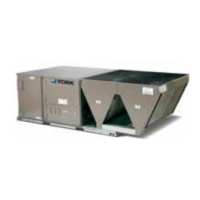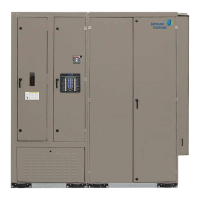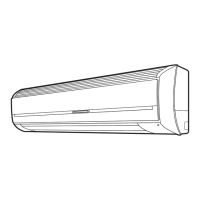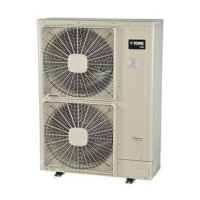5742639-JIM-C-0220
62 Johnson Controls Ducted Systems
Gas Heat Troubleshooting Guide
Before beginning symptomatic troubleshooting activities read
the flash code LEDs on the unit control board (UCB) and the
ignition control board (ICB). Fault codes have a quick sequence
of flashes indicating the flash code number followed by a pause
with the LED off. The ICB flash codes are repeated until the
fault is cleared. The ICB monitors itself, the centrifugal switch,
lockout due to > 16 pilot flame losses, primary limit, roll-out and
a flame present when the ICB expects no flame.
With power applied to the unit, if the LED on the ICB is flashing
the heartbeat and the furnace will not operate, then proceed to
the symptomatic troubleshooting section. If the ICB LED is not
flashing, then perform the ICB troubleshooting procedures. If the
ICB has a flash code other than the heartbeat, then determine
the flash code and locate its troubleshooting procedures in the
flash code troubleshooting section. Refer to Table 33 for flash
code identification and component causing fault.
Flash Code Troubleshooting
Power to the unit should be interrupted during the
troubleshooting of individual components unless otherwise
indicated. All troubleshooting procedures assume the unit is
wired per the wiring diagram. If there is any indication the unit
has been previously repaired, then the first priority is to verify
that the furnace is wired per the wiring diagram. Miss-wired
units will give false flash codes.
Ignition Control Board
The ICB controls the ignition of the pilot, the opening and
closing of the gas valves and the operation of the draft (inducer)
motor. It also monitors all the furnace safety components.
If the ICB LED is on steady, then verify the wiring of the unit to
the wiring diagram and if OK, then replace the ICB. If the unit
has power and the ICB LED is not flashing, then remove the 3
pin connector (single stage gas heat) or 4 pin connector (2
stage gas heat) from the ICB. Measure the control voltage
between terminals 1 and 2 of the wiring harness connector. The
control voltage must be between 18 and 30 volts. If control
voltage is not present, then check the 3.2A circuit breaker to
verify that the circuit breaker has control voltage on both input
and output terminals. If control voltage is present on the input
and not the output of the circuit breaker, then reset or replace
the circuit breaker as necessary. If control voltage is present on
both sides of the circuit breaker, then check the power and
common wires between the unit control box and the ICB and
repair as necessary. If the control voltage is present, then verify
the cleanliness of the harness and the ICB connector, clean if
necessary and reconnect the wiring harness to the ICB and
observe ICB LED. If it now flashes the heartbeat, then the fault
was a bad connection between the harness connector and the
ICB connector or a broken wire exists in the harness. With the
harness connected to the ICB, gently move the wires in the
harness while observing the ICB LED. If heartbeat is steady,
then verify proper operation of the furnace. If the ICB does not
flash the heartbeat, then gently move the wires in the harness
connector while observing the ICB LED. If you get any flashes
of the ICB LED, then there is still a bad connection or a broken
wire. If no flashes are seen while gently moving the wires with
the harness connected to the ICB, then replace the ICB and
verify proper operation of the furnace.
Centrifugal Switch
The centrifugal switch is an integral part of the draft motor. The
centrifugal switch closes when the motor speed increases to
~2500 rpm and opens when the motor speed descends to
~2000 rpm.
If a flash code indicates the centrifugal switch is causing a fault, then
1. If the flash code indicates the switch is open with the draft
(inducer) motor on (flash code 2), then
a. Disconnect power to the unit. Using a screw driver, spin
the draft motor blower wheel. If bound or dragging, then
visually inspect the draft motor blower wheel area for
debris. If debris is present, then clear debris and verify
proper furnace operation. If clear, then replace the draft
motor and verify proper furnace operation.
b. Restore power to unit and induce a call for heat.
Measure the voltage across the two draft motor leads
Troubleshooting of components may require opening
the electrical control box with the power connected to
the unit. Use extreme care when working with live
circuits! Check the unit nameplate for the correct line
voltage and set the voltmeter to the correct range before
making any connections with line terminals.
When not necessary, shut off all electric power to the
unit prior to any of the following maintenance
procedures so as to prevent personal injury.
Label all wires prior to disconnection when servicing
controls. Wiring errors can cause improper and
dangerous operation, which could cause injury to person
and/or damage unit components. Verify proper
operation after servicing.
The furnace may shut down on a high temperature
condition during the procedure. If this occurs, the UCB
energize the supply air blower motor until the high
temperature limit has reset. Caution should be used at
all times as the supply air blower may energize
regardless of the room thermostat fan switch position.
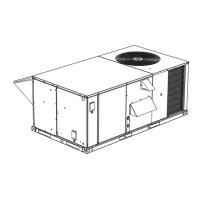
